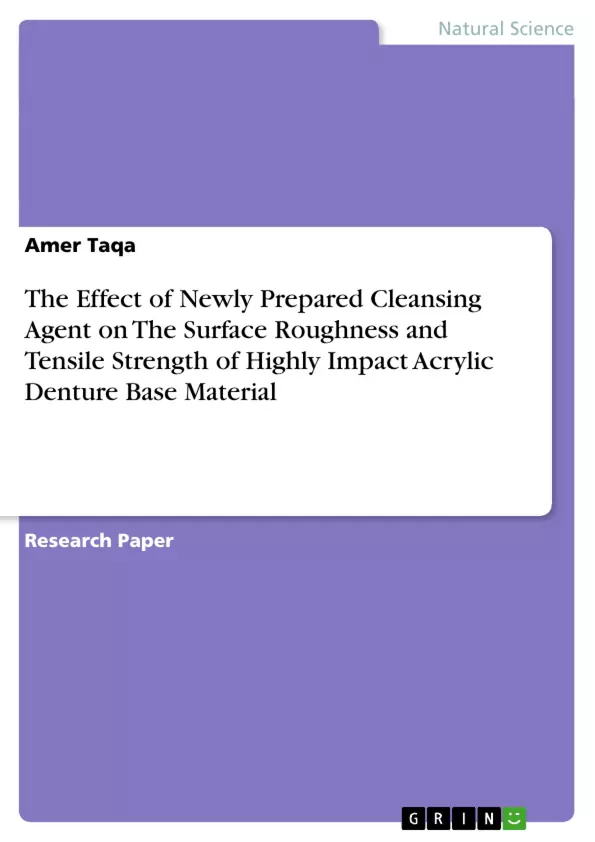Aims: To evaluate the effect of two prepared and commercial solution on surface roughness and tensile strength of highly impact acrylic denture base material Materials and Methods: The total number of specimens were one hundred and fifty. They were prepared from highly impact acrylic and subdivided into five groups for each solution (EDTA, Soda+H2O2, Lacalut, Corega and distilled water). Two laboratory tests were used for this research. Surface Roughness and tensile strength test. The surface roughness test specimens were constructed with dimensions (10×10×2±0.03mm) (length, width, and thickness respectively). According to ADA specification no.12 the tensile test specimens were constructed with dimensions 90×10×3±0.03mm (length, width, and thickness respectively). The immersion periods in this research are (2 day, 7 day and one month). ANOVA and Duncan multiple range test were used. The statistical results were considered significant at p ≤ 0.05. Results: the results showed that (soda+H2O2) has no significant change on the surface roughness and tensile strength of highly impact acrylic denture base material in (2d ay, 7 day, and 1 month) conclusion: (soda+H2O2) has the lowest effect on the surface roughness and tensile strength of highly impact acrylic denture base material in (2 day, 7 day, and 1 month)
Key words: denture cleanser, highly impact, lacalut
Inhaltsverzeichnis (Table of Contents)
- Abstract
- Introduction
- Materials and Methods
- Results
Zielsetzung und Themenschwerpunkte (Objectives and Key Themes)
This study investigates the impact of various cleansing agents on the surface roughness and tensile strength of highly impact acrylic denture base material. The research aims to evaluate the effectiveness of two prepared solutions and two commercially available denture cleansers compared to distilled water as a control.
- Surface roughness and tensile strength of highly impact acrylic denture base material
- Effect of cleansing agents on the mechanical properties of acrylic denture base material
- Comparison of the effectiveness of prepared and commercial denture cleansers
- Evaluation of the impact of immersion time on the material's properties
- The influence of denture cleanser on denture material durability
Zusammenfassung der Kapitel (Chapter Summaries)
- Abstract: Briefly outlines the study's objective, methods, and key findings, highlighting the superior performance of soda+H2O2 in preserving the material's integrity.
- Introduction: Provides background information on the use of PMMA in dentistry and its limitations in terms of impact resistance. Discusses previous attempts to enhance the strength of acrylic denture bases and the potential negative effects of cleansers on denture materials.
- Materials and Methods: Describes the methodology used in the study, including specimen preparation, immersion periods, testing procedures, and statistical analysis. Details the solutions used (EDTA, Soda+H2O2, Lacalut, Corega, and distilled water) and their preparation methods.
- Results: Presents the findings of the tensile strength and surface roughness tests, highlighting the differences in material properties based on the cleansing agents used and immersion time. The results show that soda+H2O2 had a minimal impact on the material's strength and roughness.
Schlüsselwörter (Keywords)
This research primarily focuses on the impact of denture cleansers on the mechanical properties of highly impact acrylic denture base material. Key concepts include surface roughness, tensile strength, denture cleanser effectiveness, and the influence of immersion time on material degradation. The study utilizes various cleansing agents, including EDTA, soda+H2O2, Lacalut, and Corega, to assess their effects on the material's integrity.
- Quote paper
- Amer Taqa (Author), 2012, The Effect of Newly Prepared Cleansing Agent on The Surface Roughness and Tensile Strength of Highly Impact Acrylic Denture Base Material, Munich, GRIN Verlag, https://www.hausarbeiten.de/document/210058


